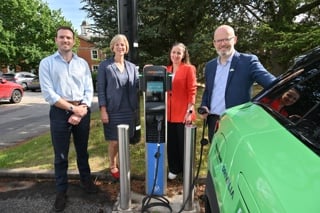Choosing the most suitable electric vehicle charge point on the public network is not always as simple as finding one in the right location with the correct power rating.
There are also other issues drivers may need to consider. For example, these could include safety or accessibility for either people with disabilities or operators of large vehicles who may find they are unable to use certain sites due to height restrictions.
These are areas recognised by EV ChargeSafe, which launched its EV ChargeSafe Data product – named Outstanding New Product of the Year in the 2023 Fleet News Awards – to help drivers identify suitable charge points.
This involves the organisation visiting public charge points and assessing them in a 144-item inspection, including taking photographs of the site and its environment.
It uses this to produce a rating up to a maximum of five stars to reflect the facilities and charge point functions and accessibility.
“EV ChargeSafe turned two years old just over a month ago and we couldn’t have anticipated the level of engagement we’ve had from the industry; it’s very difficult to get something from an idea into a fully-formed business with a proper strategy,” says Kate Tyrrell, CEO and co-founder of EV ChargeSafe.
“We were really worried when we first started out that we’d be going out and telling people they were doing it wrong and, therefore, why would you want to support a business that is telling you off every five minutes?
“But actually, companies can see it is constructive criticism, but also support to drive their businesses forward too.”
The EV ChargeSafe score is published for the public to access for free to enable them to make an informed decision on where to charge if personal safety, accessibility or ease of use are the priority.
Its ratings are independent and EV ChargeSafe does not accept funds from charge point operators (CPO) or other invested parties for anything other than the purchase of their network-specific data to understand the opportunities and challenges posed to their sites.
Fleet News: How has the past year been for EV ChargeSafe?
Kate Tyrrell: We’ve had an incredible amount of support from the industry.
We’ve also changed the way we address the delivery of our service. While we still very much have the driver as our core passion and that is who we are serving, we’ve also started to work really collaboratively with all key stakeholders in the delivery of infrastructure.
We’re working with the CPOs, local authorities, installers and architects: anybody who has a part in the process.
Instead of just saying ‘you’ve been rated 3.7 on this charger site, you need to do better’, we’ve come back to the table and said to them that we are going to run this accreditation and explained to them exactly what we will be looking at so they can start to design things better from concept to commissioning stages.
And they’ve gone ‘well, that’s brilliant, sign us up’. And the process of becoming EV ChargeSafe accredited is now a much-wanted thing.
The CPOs really want to demonstrate to their users, investors and suppliers that they are being ethical and responsible about how they design their layouts.
They can go to landowners and say ‘we need extra bay widths because if we don't put in accessible bays, we're actually in danger of indirectly discriminating against protected characteristics, and therefore could be liable for legal cases further down the line. So let's just get this right, right now’.
Whereas before, the landowners were the ones that were really controlling those conversations by saying, ‘well, if you don't give us a good price, and you don't use the space that we're giving you, your competitor will’.
So we flipped the narrative, which is really encouraging.
Fleet News: It is sometimes difficult for bigger vehicles such as vans to use the public charging network. Are you working to help them?
Kate Tyrrell: Vans are important for us. We look at the height and width restrictions on entry to a charging site because there are some that have height pillars over a car park entrance, for example, and we also look at turning circle to see if it is appropriate for an LCV.
We’re also currently working with Novuna Vehicle Solutions in how we can protect brands from public misperception, For example, ‘Sue’ is taking her mum for a food shop at Lidl but can’t plug her Hyundai Kona into the charge points there because two DPD vans are sat charging.
Instantly she’s going to be annoyed with DPD because the very first thing that could come to mind is ‘why can’t they charge somewhere else?’.
As someone involved in the charging industry I know it’s not fair to have that view because it is a public charge point. Everybody can refuel their car or van at any petrol station, so why can’t commercial EVs charge at public chargers?
We’ve been collecting data about accessibility for vans for more than a year and we want to use it to empower businesses to make better decisions about where they plug in their vehicle.
For fleets we find it’s all about the efficiency because if they are having to charge on business time, they want to make sure they are going to get in and out from the chargers relatively quickly.
One of the important factors is accessibility. If a fleet driver looks on Zap-Map, for example, and sees that if they turn left there is a 50kW charger, but if they turn right it’s a 125kW charger, then they’ll go to the 125kW.
But what happens if there’s a height restriction or they can’t physically get the vehicle on to that forecourt?
That’s when our data comes in because why would you want to sit for 20 minutes stuck in traffic attempting to get to a faster charge point without knowing you can’t physically get in there, whereas if you go five minutes the other way you can get plugged in and start to charge?
Fleet News: Since receiving the award in March last year, EV ChargeSafe has launched an app. What can you tell us about that?
Kate Tyrrell: Its main purpose could be subject to change in the future, but right now it serves as a tool to allow drivers to give us feedback on their experience of a charge point.
From that we can determine how much of a priority it is for us to send out an inspector to give it a full rating.
Moving forward, app users will maintain the inspectors’ reports by just updating us on things such as if a light bulb has gone out or if there’s graffiti on the charge point; things you need human eyeballs on.
Scores are also available and visible to drivers who might want to see how a charge site has scored.
Fleet News: What are EV ChargeSafe’s plans for 2024?
Kate Tyrrell: We’ll be looking at refreshing the app because we’ve had so much user feedback on it from our community.
We will continue to work with fleets as we see them take on more electric vehicles, we’ll also look at electric trucks and start to ensure that that infrastructure, as it goes in, is going to be worthy for the fleets that are going to need to use it.
We’ll also be taking a very close look at the American and Canadian market.






















Login to comment
Comments
No comments have been made yet.